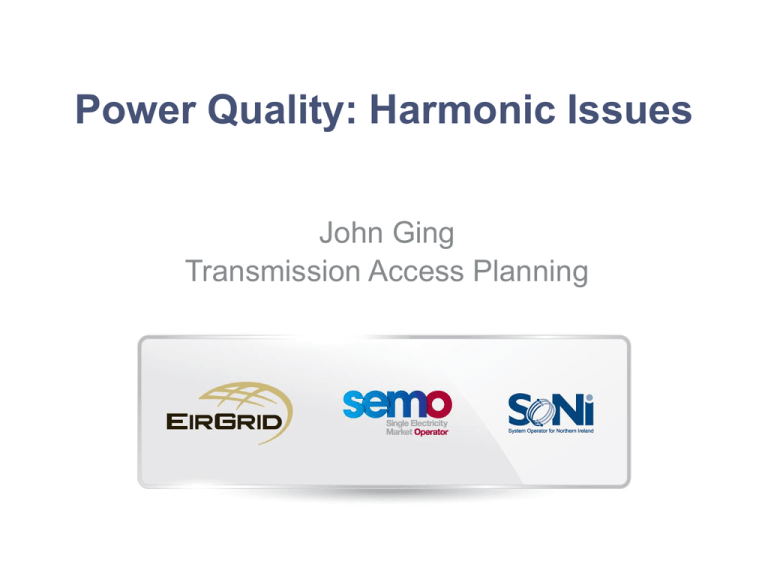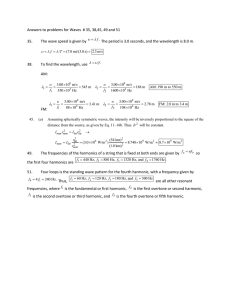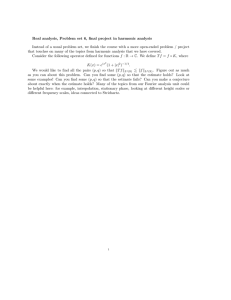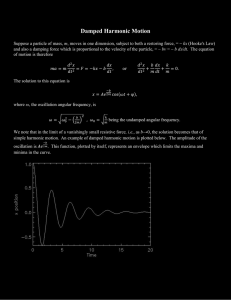View document
advertisement

Power Quality: Harmonic Issues John Ging Transmission Access Planning What are Power System Harmonics? Harmonics result in a power system waveform distortion – Signals occurring at multiples of the fundamental 50Hz frequency are superimposed onto the waveform – Destroys the smooth sinusoidal curve 3 Phase 50HzSupply signal 3 Phase 50Hz with andsignal Harmonic first Supply 4 multiples Distortion 1 50Hz 100Hz 150Hz 200Hz 1 0.8 0.8 R 0.6 0.6 0.4 0.4 0.2 0.2 S 0 -0.2 -0.2 -0.4 -0.4 -0.6 -0.6 T -0.8 -0.8 -1 -1 0 0.002 0.004 pi/2 0.006 0.008 5pi/6 0.01 pi 7pi/6 0.012 Tim eradians (s e conds ) 0.014 3pi/2 0.016 0.018 0.02 2pi What are the harmonic sources? • Caused by the non-linearity of customer loads. – A result of devices drawing non-sinusoidal current from a sinusoidal voltage source – These non-linear loads generate harmonic currents which interact with the system impedance instigating a harmonic voltage distortion. • Commonly generated by rectifying devices Power Electronics Power converters Variable frequency drives DC motor controllers Cycloconverters Static Var Compensators Steel mills Power supplies, UPS and Battery Chargers Inverters ARC devices Fluorescent lighting ARC furnaces Welding machines Why are Harmonic problems becoming an increasing concern? • Increasing use of power electronics and converters (particularly for wind turbines) are injecting more harmonic currents onto the system • The influx of more cables onto the network exacerbate the problem by changing the network impedance • Cables amplify any harmonic injections present EirGrid have been analysing power system harmonics for a number of years • Not a problem that is unique to Ireland EirGrid have discussed the issues and mitigation with other TSOs What does this mean? Harmonic related distortions can result in the failure or mal-operation of end-use equipment – – – – – – Increases the current in the system (i.e. higher losses) Overheating in transformers, motors and neutral wires Improper operation of Protection relays Can resonate with system Capacitor Banks Telecommunications interference Misfiring from incorrect triggering at “zero-crossings” • i.e. multiple crossings of the x-axis can wreak havoc on the timing signals used for Digital Circuits; Rectifiers, Thyristors and Inverters Harmonic disturbances 50Hz 50Hz signal signal with and Harmonic triggering Disturbance on x = 0 axis and crossings triggering 1 0 -1 0 0.01 0.01 0.004 0.020.006 0.03 0.008 0.01 0.04 0.0120.05 0.014 0.06 0.016 Tim e (s e conds ) 0.018 0.07 0.02 0.08 How can harmonics be mitigated? This is a complex issue with several options available: – Analysis to determine the most cost-effective and enduring solution – Interactions with neighbouring projects increase complexity – One or more options from the table below may be required Option Details Issues System Reinforcement Increase the Short Circuit Level in the Region Potentially expensive, Possibly long lead times, Requires knowledge of permanent connection of offers Isolation transformers Some higher frequencies can be attenuated by certain transformer winding configurations Not applicable for all harmonic orders, Potentially expensive Harmonic injection limitation Reduce injections from plant by enforcing limits Some plant perform better than others for minimising harmonic injections, can potentially be the cheapest viable solution Passive Filters Tuned inductive reactors and a capacitance attenuate select frequencies Depends on system impedance which changes over time, Requires knowledge of permanent connection of offers Active Filters Automatically tuned reactors and capacitance attenuate select frequencies Expensive, Stable operation against impedance changes but may interact with nearby projects Grid Code Requirements CC.10.13 Power Quality – Users shall ensure that their connection to the Transmission System does not result in the level of distortion or fluctuation of the supply Voltage on the Transmission System, at the Connection Point, exceeding that allocated to them following consultation with the TSO. – Distortion and fluctuation limits are outlined in IEC/TR3 61000-3-6 (Harmonics) and IEC/TR3 61000-3-7 (Voltage fluctuation). Users shall also operate their Plant in a manner which will not cause the requirements contained in CENELEC Standard EN 50160 to be breached. What are EirGrid doing? • Background harmonic data being recorded at various stations for model building and verification • Studies for select nodes with significant cable build are underway (South West, North West) • Further studies will be compiled after offer acceptance (and cable request modifications are received) • Harmonic limits will be defined with suitable margins retained as appropriate for future system integrity reasons • Harmonic Voltage Limits and Impedance loci will be ascertained and communicated with relevant customers – Theses limits can be used to select turbines with suitable injections – The Impedance loci are useful for filter design to ensure the limits are satisfied What must customers do? Prior to receipt of Harmonic Injection Limits and Impedance loci Contact the System Operator well in advance of any potential cable request modifications Notify the System Operator of turbine types or reactive power devices on site as early as possible After obtaining Harmonic Injection Limits and Impedance loci from the System Operator, some or all of the following may be required Purchase/Install turbines that have limited harmonic injections at the specified frequencies Install harmonic mitigation plant such as filters to reduce harmonic injections below acceptable levels at the specified frequencies Communicate the parameters of the solution devices with the System Operator More details can be found in our Harmonics Information note www.eirgrid.com/aboutus/publications


